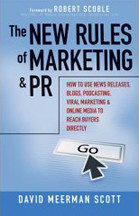“The blogosphere is all about Internet links that move faster and more efficiently than the traditional word-of-mouth advertising.” Tracey Clark, May Papers
From Maria Piscopo’s article in Communication Arts, Tracey Clark believes in blog marketing. She's not the only one. And for good reason.
It took me less than a minute to find Clark’s e-mail and congratulate her on a prolific quote. The same day, she wrote me back, thanking me and mentioning that she didn’t know the article was up. I almost e-mailed her back to say I didn’t know if it was up on the net or not; I had read the hard copy version of Communication Arts. (How barbaric of me to say so, but Communication Arts is one of my few hard copy vices.) The assumption though is part of the story. The speed of being able to have a brief communication exchange took hours.
Do you remember how long something like that would take? Weeks? Months? Never?
In the article, Clark also mentions how quickly she understood the potential. Within her first month of blogging, she was featured as the “momtreprenner” of the month by a highly trafficked shopping blog for moms. Another featured blogger in the article, John Janstch, says he can track as much as $500,000 worth of business to his blog. There are more case studies to consider. We have a few here at Copywrite, Ink. too.
Social media works because as Clark’s quote sums, word-of-mouth marketing, one-on-one communication, or frontline communication have always been recognized as the most credible forms of communication. The down side was that it used to be slow – travel, meetings, follow-ups, phone calls, introductions.
Social media, blogs specifically, have a unique ability to create that one-on-one communication link between the blogger and the reader, which is reinforced by open participation in comment sections. It makes sense that individuals and small businesses were the first to employ them because blogs, unless overburdened by puffery, provide a better return on investment than other communication tactics on their own. Sure, it still takes some time and it is better to have someone on board who can write well; but that’s where companies like ours fit into the mix.
Ironically, this blogger-to-reader model is one of several hold backs for most businesses. Most executives don’t have the time nor the inclination to peddle their companies with a blog. And more than that, as I offered up on recruitingblogs.com, is that any trepidation is not because of blogdramas or personal blogs as some claim. It is because of what David Meerman Scott and I pointed out some time ago: there is too much gibberish. When you talk to people who are not immersed in social media, their eyes glaze over if you rattle off traffic, rank, connections, and influence.
In contrast, you can see the lights turn back on when you mention that Southwest Airlines attributes $150 million in ticket sales to its widget, which is part of its social media mix.
So what is really going on? Social media gibberish is beginning to outweigh the significance that social media can add to business strategy which is an opportunity to communicate with the power of one-on-one communication, develop a dedicated online publication (as opposed to e-mail blasts), or whatever 5-in-1 tool you can dream up.
The more businesses hear about these possibilities, the more likely they will engage in social media. But, if you ask me, eventually, they will embrace it anyway. Because, you see, the times are changing.
Right. The New York Times is changing (Hat tip: Jane Sweat). Effective today, The New York Times is ending TimesSelect and opening its content, archives, and other features for free. Why? Take it from the Times.
“Since we launched TimesSelect in 2005, the online landscape has altered significantly. Readers increasingly find news through search, as well as through social networks, blogs and other online sources. In light of this shift, we believe offering unfettered access to New York Times reporting and analysis best serves the interest of our readers, our brand and the long-term vitality of our journalism. We encourage everyone to read our news and opinion – as well as share it, link to it and comment on it.”

From Maria Piscopo’s article in Communication Arts, Tracey Clark believes in blog marketing. She's not the only one. And for good reason.
It took me less than a minute to find Clark’s e-mail and congratulate her on a prolific quote. The same day, she wrote me back, thanking me and mentioning that she didn’t know the article was up. I almost e-mailed her back to say I didn’t know if it was up on the net or not; I had read the hard copy version of Communication Arts. (How barbaric of me to say so, but Communication Arts is one of my few hard copy vices.) The assumption though is part of the story. The speed of being able to have a brief communication exchange took hours.
Do you remember how long something like that would take? Weeks? Months? Never?
In the article, Clark also mentions how quickly she understood the potential. Within her first month of blogging, she was featured as the “momtreprenner” of the month by a highly trafficked shopping blog for moms. Another featured blogger in the article, John Janstch, says he can track as much as $500,000 worth of business to his blog. There are more case studies to consider. We have a few here at Copywrite, Ink. too.
Social media works because as Clark’s quote sums, word-of-mouth marketing, one-on-one communication, or frontline communication have always been recognized as the most credible forms of communication. The down side was that it used to be slow – travel, meetings, follow-ups, phone calls, introductions.
Social media, blogs specifically, have a unique ability to create that one-on-one communication link between the blogger and the reader, which is reinforced by open participation in comment sections. It makes sense that individuals and small businesses were the first to employ them because blogs, unless overburdened by puffery, provide a better return on investment than other communication tactics on their own. Sure, it still takes some time and it is better to have someone on board who can write well; but that’s where companies like ours fit into the mix.
Ironically, this blogger-to-reader model is one of several hold backs for most businesses. Most executives don’t have the time nor the inclination to peddle their companies with a blog. And more than that, as I offered up on recruitingblogs.com, is that any trepidation is not because of blogdramas or personal blogs as some claim. It is because of what David Meerman Scott and I pointed out some time ago: there is too much gibberish. When you talk to people who are not immersed in social media, their eyes glaze over if you rattle off traffic, rank, connections, and influence.
In contrast, you can see the lights turn back on when you mention that Southwest Airlines attributes $150 million in ticket sales to its widget, which is part of its social media mix.
So what is really going on? Social media gibberish is beginning to outweigh the significance that social media can add to business strategy which is an opportunity to communicate with the power of one-on-one communication, develop a dedicated online publication (as opposed to e-mail blasts), or whatever 5-in-1 tool you can dream up.
The more businesses hear about these possibilities, the more likely they will engage in social media. But, if you ask me, eventually, they will embrace it anyway. Because, you see, the times are changing.
Right. The New York Times is changing (Hat tip: Jane Sweat). Effective today, The New York Times is ending TimesSelect and opening its content, archives, and other features for free. Why? Take it from the Times.
“Since we launched TimesSelect in 2005, the online landscape has altered significantly. Readers increasingly find news through search, as well as through social networks, blogs and other online sources. In light of this shift, we believe offering unfettered access to New York Times reporting and analysis best serves the interest of our readers, our brand and the long-term vitality of our journalism. We encourage everyone to read our news and opinion – as well as share it, link to it and comment on it.”



















